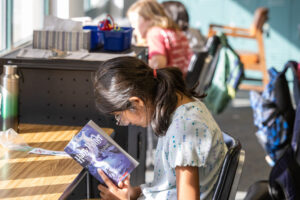Academic Overview
RATIONALE AND PURPOSE
Our world is best served when all people have the opportunity to develop to their fullest capacity. Thus, our program attempts to meet the unique needs of unique individuals by providing opportunities for them to develop their potentialities. We believe that “nothing is more unequal than equal treatment of unequals”.
The ideas and interests of young, gifted children are often so different from their age peers that they feel out of place and seek older friends. This situation gives the younger child less chance for leadership and less chance to feel positively about his or her abilities. Our school provides a place for gifted children to develop peer age friendships, an opportunity for leadership, and a place where special abilities are valued.
The purpose of our curriculum is to maximize the intellectual, social, and emotional capacities of gifted children. The innate abilities of the gifted child need to be nurtured, stimulated, and rewarded. Our program provides learning experiences to develop those special skills and abilities.
It is our aim to teach students to value and respect the unique abilities of themselves and others. We try to provide a warm, caring environment in which everyone, students and teachers, can learn and grow.
DEFINITION
Gifted children are those who are identified by a variety of measures to demonstrate actual or potential high abilities in creative, academic, or intellectual areas. Students are accepted at University School for their high academic potential.
THE PROGRAM
University School is a full school program for gifted children from age three through eighth grade. The purpose of the school is to provide an emotionally supportive and intellectually challenging learning environment that rewards both creativity and socially responsible behavior. We believe that a person learns best in a supportive, but kindly firm, atmosphere where he or she is actively involved and has some control over what occurs. We know that each student is an individual and therefore we do not expect uniform educational results.
Flexible pacing is provided for all children at our school. A new student told his teacher with delight, “This is a school where you just study what you need to learn.” One of the most widely used methods is open-ended materials and activities. The other is grouping of students according to specific academic skills. Our low pupil/teacher ratio allows us to provide a great deal of individual attention to children. The University School Enaction Curriculum is designed to meet the special needs of gifted children by developing their capacities for thinking and problem solving and by providing stimulating and challenging work. The Enaction Curriculum is based on active interdisciplinary learning with an emphasis on learning to work hard and put forth effort.
Our grouping of students is designed to be flexible. Children are grouped according to reading, math, other abilities, personal interests and sometimes according to age. Placement will also depend on the development of fine motor skills, task commitment, social and emotional development and interest in more abstract tasks.
Guide to Class Names
University School’s class designations do not conform to those traditionally found at other schools. Our students are generally significantly more advanced in their academic level than their peers of the same age. We have the flexibility to have students of a variety of ages in the same class and have purposefully chosen class names that are “outside the box” to reflect our philosophy and program.
To help you make a connection with traditional grade levels, the following list will give you a general idea of the equivalent grade that each of our classes represents based on students’ ages:
Lower School
- Early Childhood — Preschool (generally 3 and 4 year olds)
- Early Primary — PreK (generally 4 and 5 year olds)
- Primary 1 — Kindergarten
- Primary 2 — 1st Grade
- Primary 3 — 2nd Grade
Upper School
- Intermediate 1 — 3rd Grade
- Intermediate 2 — 4th Grade
- Older Intermediate 5 — 5th Grade
- Older Intermediate 6 — 6th Grade
- Older Intermediate 7 — 7th Grade
- Older Intermediate 8 — 8th Grade
ALL LEVELS
Interdisciplinary learning is encouraged. Thus a variety of disciplines often focus on a single theme. Students are also taught planning, decision-making, communication skills, and forecasting – all of which helps them to develop a variety of individual talents and thinking skills. Students at all levels take Spanish, music, art, and age-appropriate computer classes.
